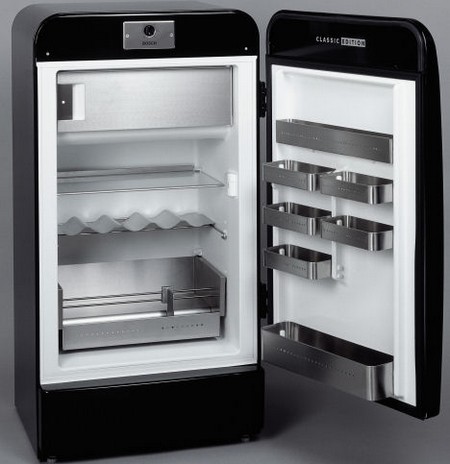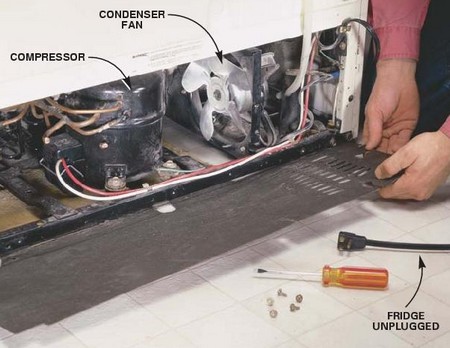Electric refrigerators are subject to operating troubles just like any other major appliance. If the motor is defective, as shown by the fact that it won’t run or runs hot and emits an unpleasant odor, a refrigerator repair service should replace it. Otherwise, the do-it-yourselfer can do many types of repair over a weekend.
TROUBLESHOOTING
If the motor runs too much, the condenser coils might be dirty or the door might leak air. The refrigerator might be located too near a stove or other hot surface, so it has to work hard to cool the air. Or it might be too close to a wall, so there’s not enough air circulation for proper cooling. The refrigerator should be at least 4 inches from the wall and ceiling.
A refrigerator condenser, usually located at the back or the bottom of the machine, needs cleaning at least once a year. Before cleaning it, however, always disconnect the power. After locating the condenser, clean the coils with a vacuum cleaner brush attachment or a long-handled brush.
If the refrigerator is noisy, the noise may be due to motor defects, in which case a service person should be called. However, before doing so check the following to make sure the noise doesn’t originate with them. First test the refrigerator with a carpenter’s level. If the refrigerator is off plumb, adjust the leveling screws under the legs until the unit is completely level. If you run out of adjustment, place wood shims or metal disks under the legs. Also tighten all screws, bolts, and nuts, including those on the motor frame or housing. Finally, examine the motor belt, if there is one. If it is too loose, it may slap or squeak.
Adjust it. If the belt is fabric, you can eliminate squeaks by rubbing it with soap or spraying it with belt dressing.
Refrigerator door gaskets often become defective, permitting air to leak into the box and causing the motor to overrun. This, in turn, causes frost buildup, which requires defrosting. Test the door for tightness by placing a piece of paper between the door and the door frame. If you can pull the paper out without a tug, the door gasket is bad. Remove the old gasket and replace it with a new one available from an appliance parts house in larger cities. Make sure you have the model number to ensure an exact replacement. If the refrigerator door has a latch, check to ensure that is adjusted for a tight close.
If a frostless refrigerator requires defrosting, and the gasket is in good condition, maybe the last defrosting process was incomplete. Otherwise, you may have kept the temperature too low because you wanted the machine to freeze quickly. Refrigerator temperature should never be lower than 35 degrees Fahrenheit, and remains preferably between 40 and 45 degrees. Frost forms rapidly when the unit is kept colder than 35 degrees. A simple low-range thermometer places in the operating refrigerator for an hour will tell you whether the unit is working efficiently.
ELECTRICAL TROUBLESHOOTING
If you have a basic understanding of electricity, you may want to test some of the electrical components in your refrigerator that sometimes fail: the overload protector, the relay, the temperature control or thermostat, and the defrost timer. You’ll often find a location and wiring diagram for these components on the back side of your refrigerator or in the owner’s manual. In many units, these components are located in the area under the refrigerator (accessible through the grill below the front door, or, in the case of the thermostat, inside).
To test the overload protector, remove the wires and test for continuity across the terminals. Replace the overload protector if there is no reading at room temperature.
To test the relay, check for continuity between terminals L and R, and between S and L. Replace the relay if there is no reading between L and R, or if there is a reading between S and L.
To test the temperature control/thermostat, remove the wire, turn the control to the coldest setting, and test for continuity across the terminals. Replace the temperature control if there is no reading.
To test the defrost timer, remove the wires and test for continuity across terminals for the timer motor, the compressor circuit, and the defrost circuit. Replace the defrost timer if any of the circuits are open.
You can also test the compressor with a continuity tester or ohmmeter following the manufacturer’s wiring diagram. However, no one except an experienced service person should reinstall the compressor.
LEAKS
Refrigerant leaks are easy to find. First look for oil stains throughout the oil cooler and condenser tubes. You can also wipe the area with liquid dish soap and watch for bubbles. However, if you find a leak, you should leave the patching and recharging of the system to a qualified service person to ensure that you don’t damage the refrigerator or injure yourself.

